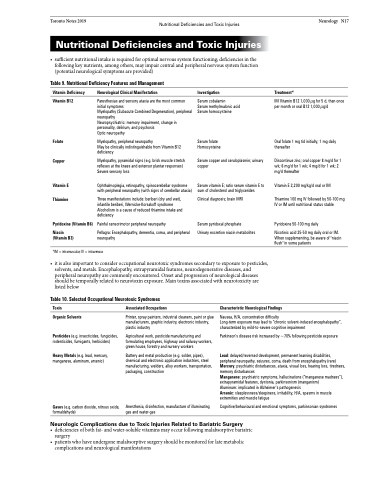Page 759 - TNFlipTest
P. 759
Toronto Notes 2019 Nutritional Deficiencies and Toxic Injuries Nutritional Deficiencies and Toxic Injuries
• sufficientnutritionalintakeisrequiredforoptimalnervoussystemfunctioning;deficienciesinthe following key nutrients, among others, may impair central and peripheral nervous system function (potential neurological symptoms are provided)
Neurology N17
Table 9. Nutritional Deficiency Features and Management
Vitamin Deficiency
Vitamin B12
Folate Copper
Vitamin E Thiamine
Pyridoxine (Vitamin B6)
Niacin (Vitamin B3)
Neurological Clinical Manifestation
Paresthesias and sensory ataxia are the most common initial symptoms
Myelopathy (Subacute Combined Degeneration), peripheral neuropathy
Neuropsychiatric: memory impairment, change in personality, delirium, and psychosis
Optic neuropathy
Myelopathy, peripheral neuropathy
May be clinically indistinguishable from Vitamin B12 deficiency
Myelopathy, pyramidal signs (e.g. brisk muscle stretch reflexes at the knees and extensor plantar responses) Severe sensory loss
Ophthalmoplegia, retinopathy, spinocerebellar syndrome with peripheral neuropathy (with signs of cerebellar ataxia)
Three manifestations include: beriberi (dry and wet), infantile beriberi, Wernicke-Korsakoff syndrome Alcoholism is a cause of reduced thiamine intake and deficiency
Painful sensorimotor peripheral neuropathy
Pellagra: Encephalopathy, dementia, coma, and peripheral neuropathy
Investigation
Serum cobalamin
Serum methylmalonic acid Serum homocysteine
Serum folate Homocysteine
Serum copper and ceruloplasmin; urinary copper
Serum vitamin E; ratio serum vitamin E to sum of cholesterol and triglycerides
Clinical diagnosis; brain MRI
Serum pyridoxal phosphate
Urinary excretion niacin metabolites
Treatment*
IM Vitamin B12 1,000 μg for 5 d, then once per month or oral B12 1,000 μg/d
Oral folate 1 mg tid initially; 1 mg daily thereafter
Discontinue zinc; oral copper 8 mg/d for 1 wk; 6 mg/d for 1 wk; 4 mg/d for 1 wk; 2 mg/d thereafter
Vitamin E 2,200 mg/kg/d oral or IM
Thiamine 100 mg IV followed by 50-100 mg IV or IM until nutritional status stable
Pyridoxine 50-100 mg daily
Nicotinic acid 25-50 mg daily oral or IM. When supplementing, be aware of "niacin flush" in some patients
*IM = intramuscular; IV = intravenous
• itisalsoimportanttoconsideroccupationalneurotoxicsyndromessecondarytoexposuretopesticides, solvents, and metals. Encephalopathy, extrapyramidal features, neurodegenerative diseases, and peripheral neuropathy are commonly encountered. Onset and progression of neurological diseases should be temporally related to neurotoxin exposure. Main toxins associated with neurotoxicity are listed below
Table 10. Selected Occupational Neurotoxic Syndromes
Toxin
Organic Solvents
Pesticides (e.g. insecticides, fungicides,
rodenticides, fumigants, herbicides)
Heavy Metals (e.g. lead, mercury, manganese, aluminum, arsenic)
Gases (e.g. carbon dioxide, nitrous oxide, formaldehyde)
Associated Occupations
Printer, spray painters, industrial cleaners, paint or glue manufacturers, graphic industry, electronic industry, plastic industry
Agricultural work, pesticide manufacturing and formulating employees, highway and railway workers, green house, forestry and nursery workers
Battery and metal production (e.g. solder, pipes), chemical and electronic application industries, steel manufacturing, welders, alloy workers, transportation, packaging, construction
Anesthesia, disinfection, manufacture of illuminating gas and water-gas
Characteristic Neurological Findings
Nausea, H/A, concentration difficulty
Long-term exposure may lead to “chronic solvent-induced encephalopathy”, characterized by mild-to-severe cognitive impairment
Parkinson’s disease risk increased by ~70% following pesticide exposure
Lead: delayed/reversed development, permanent learning disabilities, peripheral neuropathy, seizures, coma, death from encephalopathy (rare) Mercury: psychiatric disturbances, ataxia, visual loss, hearing loss, tiredness, memory disturbances
Manganese: psychiatric symptoms, hallucinations (“manganese madness”), extrapyramidal features, dystonia, parkinsonism (manganism)
Aluminum: implicated in Alzheimer’s pathogenesis
Arsenic: sleeplessness/sleepiness, irritability, H/A, spasms in muscle extremities and muscle fatigue
Cognitive/behavioural and emotional symptoms, parkinsonian syndromes
Neurologic Complications due to Toxic Injuries Related to Bariatric Surgery
• deficienciesofbothfat-andwater-solublevitaminsmayoccurfollowingmalabsorptivebariatric surgery
• patientswhohaveundergonemalabsorptivesurgeryshouldbemonitoredforlatemetabolic complications and neurological manifestations


